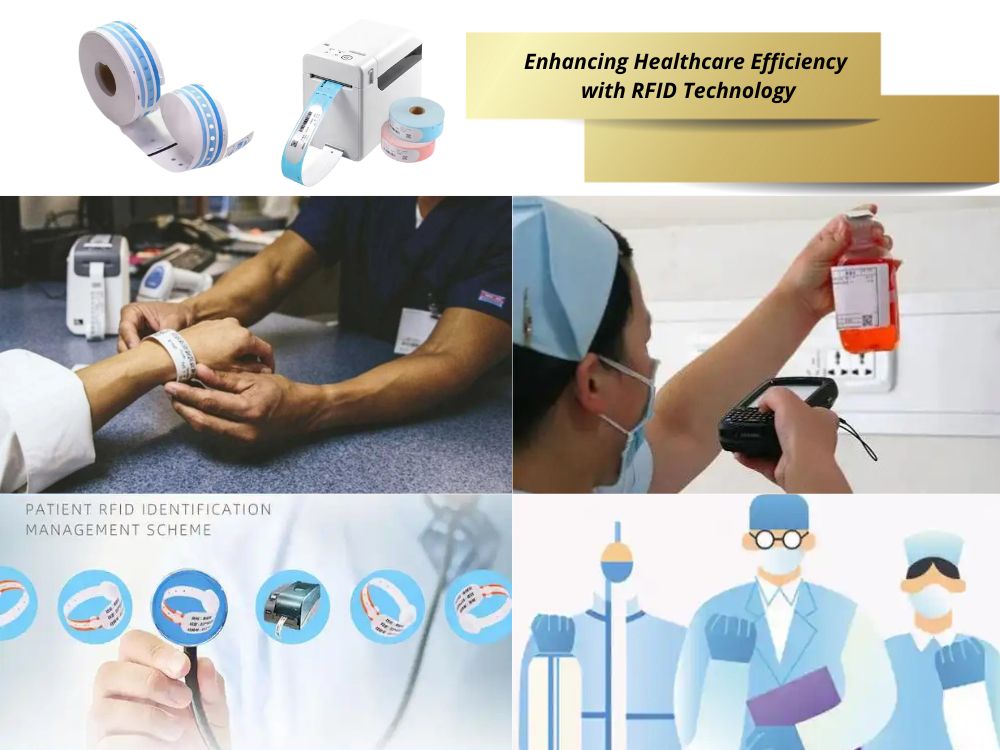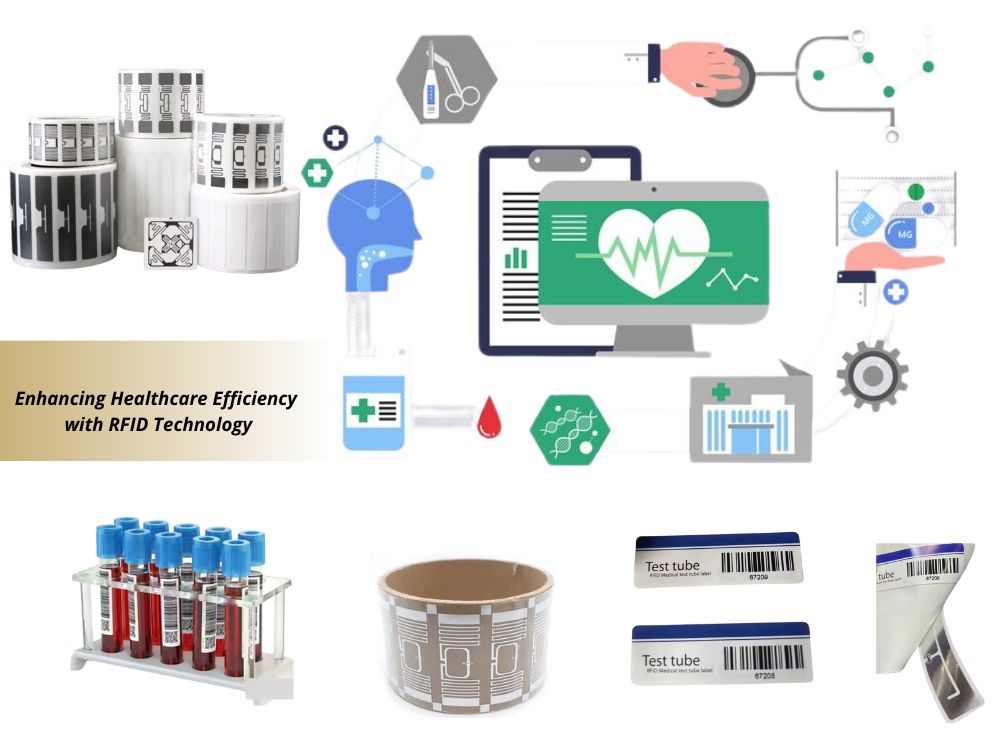
Enhancing Healthcare Efficiency with RFID Technology
Table of Contents
Summary
By automating and streamlining various processes, RFID solutions help healthcare providers meet increasing demands with greater precision and reduced administrative burden.
This article explores five pivotal ways in which RFID technology supports the healthcare sector, enhancing operational effectiveness and service delivery.

Optimizing Lone Care Worker Monitoring
Lone care workers, who frequently visit patients’ homes, benefit greatly from RFID technology. The system automates the recording of attendance and travel times by attaching NFC (Near Field Communication) RFID labels at entry and exit points. Each time a care worker arrives or departs, the RFID system logs the time and updates the central database. This data is then accessible to supervisors, enabling real-time tracking of care worker locations and simplifying timesheet management.
Feature | Benefit |
NFC RFID Labels | Automated time logging |
Central Database | Real-time tracking and data accessibility |
Supervisory Access | Enhanced oversight and efficiency |
Streamlining Equipment Tracking for Service Providers
Healthcare suppliers and service providers leverage RFID to manage equipment such as specialized beds, inflatable mattresses, and pumps. Each component is tagged with RFID, allowing for seamless tracking throughout its lifecycle. RFID systems facilitate proof of delivery, monitor cleaning and maintenance, and ensure that equipment is returned and serviced promptly.
Component | RFID Application |
Specialized Beds | Proof of delivery and condition tracking |
Inflatable Mattresses | Maintenance scheduling and verification |
Pumps | Service and cleaning documentation |
Enhancing Ambulance Service Efficiency
In emergency medical services, RFID technology ensures that ambulances are consistently stocked with necessary equipment. Custom application software integrated with RFID helps verify that all required medical supplies are onboard before deployment. This system enhances preparedness and reduces the risk of missing critical items during emergency responses.
Equipment | RFID Role |
Emergency Medical Supplies | Verification and inventory management |
Ambulance Equipment | Real-time monitoring and tracking |
Tracking Oxygen and Nitrous Oxide Cylinders
RFID technology supports efficient tracking of oxygen and nitrous oxide cylinders in healthcare settings. The system monitors the availability and usage of cylinders, predicting future requirements based on current usage patterns. This predictive capability aids in timely replenishment and ensures that supplies meet demand without delay.
Cylinder Type | RFID Function |
Oxygen Cylinders | Usage tracking and demand forecasting |
Nitrous Oxide Cylinders | Inventory management and supply planning |

Managing Bicycle Loans for Staff Transportation
In response to the need for efficient staff transportation within large health centers, such as Nightingale hospitals, RFID technology is used to manage bicycle loans. Each bicycle is tagged with RFID, allowing for accurate tracking of dispatch and return times. This system helps ensure that bikes are efficiently allocated and monitored throughout their use.
Bicycle Management | RFID Benefits |
Dispatch and Return | Accurate tracking and inventory control |
Allocation Efficiency | Streamlined loan process and monitoring |
Conclusion
RFID technology plays a crucial role in modernizing healthcare operations, enhancing efficiency, and improving service delivery. By automating monitoring, tracking, and data management processes, RFID solutions address key challenges faced by healthcare providers and support them in delivering high-quality care.
These applications exemplify how RFID technology can be effectively harnessed to meet the dynamic needs of the healthcare sector, ultimately contributing to better patient outcomes and streamlined operations.
Comments
Hot Products

What Is RFID Waste Management
Imagine a city where every trash bin speaks — not literally — but through a tiny chip that tells the system when it’s full, when it’s emptied, and where it went. That’s what RFID waste management is doing today.

What are Bolt Seals and their Applications? | Complete Guide
In global trade and logistics, bolt seals play a crucial role in ensuring cargo security and compliance. These small but powerful devices are designed to lock shipping containers, trailers, and cargo doors with a tamper-evident mechanism.

What is an RFID Card Protector? Benefits, Use Cases, and Buying Guide
RFID technology (Radio Frequency Identification) is everywhere: in your credit cards, ID badges, transit passes, hotel room keys, and more. It offers speed and convenience, but it also opens the door to a new kind of digital theft called “skimming.” That’s where an RFID card protector comes in.

RFID Wristbands for Events: Bulk Buying Guide for Organizers
RFID wristbands for events are becoming the go-to solution for organizers who need faster entry, fraud prevention, and cashless payments at concerts, festivals, and sports venues. Unlike paper tickets or QR codes, these smart wristbands use embedded chips to streamline access, secure transactions, and improve the guest experience.

How RFID Tag on Windscreen Improves Vehicle Access Control and Toll Systems
In today’s fast-paced world, vehicle identification needs to be quick, secure, and contactless. An RFID Tag on the Windscreen provides exactly that — a reliable way to manage toll collection, parking, and gated access without stopping vehicles.

The Benefits of RFID Linen Tags in Commercial Laundry
Managing laundry in hospitals, hotels, or large laundry services is a big job. Each day, thousands of sheets, towels, and uniforms are washed, sorted, and sent back out. But problems like lost linens, sorting mistakes, and manual counting can cost companies a lot of money. For example, mid-sized hotels can lose over $200,000 each year from missing linens.
That’s where RFID Linen Tags come in.
Tags
RELATED BLOGS

What Is RFID Waste Management
Imagine a city where every trash bin speaks — not literally — but through a tiny chip that tells the system when it’s full, when it’s emptied, and where it went. That’s what RFID waste management is doing today.

What are Bolt Seals and their Applications? | Complete Guide
In global trade and logistics, bolt seals play a crucial role in ensuring cargo security and compliance. These small but powerful devices are designed to lock shipping containers, trailers, and cargo doors with a tamper-evident mechanism.

What is an RFID Card Protector? Benefits, Use Cases, and Buying Guide
RFID technology (Radio Frequency Identification) is everywhere: in your credit cards, ID badges, transit passes, hotel room keys, and more. It offers speed and convenience, but it also opens the door to a new kind of digital theft called “skimming.” That’s where an RFID card protector comes in.




